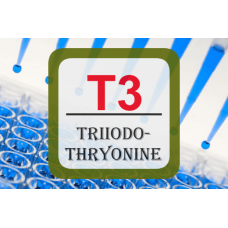Shopping Cart
0 item(s) - $0.00Thyroid Hormone ELISA - T3
Availability: In Stock
Add to Compare
Enzyme Immunoassay for the Quantitative Determination of Triiodothyronine (T3) in Human Serum
FOR RESEARCH USE ONLY. NOT FOR USE IN DIAGNOSTIC PROCEDURES
SUMMARY
The thyroid hormones, thyroxine (T4) and 3, 5, 3 triiodothyronine (T3) circulate in the bloodstream mostly bound to the plasma protein, thyroxine binding globulin (TBG).1 The concentration of T3 is much less than that of T4, but its metabolic potency is much greater.2,3 These as well as other hormones are produced by the thyroid gland, situated at the level of the thyroid cartilage on either side of the larynx. The thyroid gland and associated hormones are a major component of the endocrine system. They exert powerful and essential regulatory influences on growth, differentiation, cellular metabolism, and general hormonal balance of the body, as well as on the maintenance of metabolic activity and the development of the skeletal and organ systems.
T3, T4 and TSH determination are important factors in thyroid disease diagnosis. T3 determination is useful in monitoring both patients under treatment for hyperthyroidism, and patients who have discontinued anti-thyroid drug therapy. It is especially valuable in distinguishing between euthyroid and hyperthyroid subjects.
T3 measurement has uncovered a variant of hyperthyroidism in thyrotoxic patients with elevated T3 values and normal T4 values.5 Likewise, an increase in T3 without an increase in T4 is frequently a forerunner of recurrent thyrotoxicosis in previously treated patients. In addition to hyperthyroidism, T3 levels are elevated in women who are pregnant, and in women receiving oral contraceptives or estrogen treatment. The clinical significance of T3 is also evident in patients where euthyroidism is attributable only to normal T3, although their T4 values are subnormal.
PRINCIPLE OF THE TEST
In the United Immunoassay T3 EIA, a second antibody (goat anti-mouse IgG) is coated on a microtiter wells. A measured amount of patient serum, a certain amount of mouse monoclonal Anti-T3 antibody, and a constant amount of T3 conjugated with horseradish peroxidase are added to the microtiter wells. During incubation, the mouse anti-T3 antibody is bound to the second antibody on the wells. T3 and the enzyme conjugated-T3 compete for the limited binding sites on the anti-T3 antibody. After a 60 minute incubation at room temperature, the wells are washed 5 times by water to remove unbound T3 conjugate. A solution of TMB is then added and incubated for 20 minutes at room temperature, resulting in the development of a blue color. The color development is stopped with the addition of 1N HCl, and the absorbance is measured spectrophotometrically at 450 nm. The intensity of the color formed is proportional to the amount of enzyme present, and is inversely related to the amount of unlabeled T3 standards assayed in the same way. The concentration of T3 in the unknown sample is then calculated.
EXAMPLE OF STANDARD CURVE
Results of a typical standard run with optical density readings at
450 nm shown in the Y axis against Thyroid Hormone concentrations shown in the X axis. This standard curve is for the purpose of illustration only, and should not be used to calculate unknowns. Each user should obtain his or her own data and standard curve.

| General | |
| ANALYTE GROUP | Thyroid Hormone |
| GROUPING | Hormones:Thyroid |
| PRODUCT NAME | ELISA |
| STORAGE | Store the kit at 2-8°C |
| COUNTRY OF ORIGIN | USA |
| DISCOUNTS | Bulk Packaging; High Volume |
| ELISA | |
| TESTS PER KIT | 96 (12 x 8) |
| CALIBRATION RANGE | 0 - 10 ng/mL (Recommended) |
United Immunoassay, Inc. © 2025


































